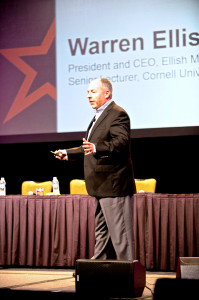Call 303-808-4680
Posts tagged International Franchise Association
Soccer Shots Selects Warren Ellish to Keynote 10th Annual Franchise Convention
 Warren Ellish, President & CEO of Ellish Marketing Group and Senior Lecturer at Cornell University’s Johnson Graduate School of Management will be the keynote speaker at the 10th annual Soccer Shots National Fracnhise Convention. The convention will be held on Saturday July 19, 2014 in Chicago at the Hyatt Regency McCormick Place. Warren’s keynote will address “The Three Critical Steps to Positioning Your Franchise Into a World-Class Brand.”
Warren Ellish, President & CEO of Ellish Marketing Group and Senior Lecturer at Cornell University’s Johnson Graduate School of Management will be the keynote speaker at the 10th annual Soccer Shots National Fracnhise Convention. The convention will be held on Saturday July 19, 2014 in Chicago at the Hyatt Regency McCormick Place. Warren’s keynote will address “The Three Critical Steps to Positioning Your Franchise Into a World-Class Brand.”
Soccer Shots is the leader in youth soccer development for children ages 2-8. Their nationally recognized program offers a high energy, fun, age-appropriate introduction to the wonderful game of soccer. Their innovative curriculum emphasizes both soccer skills and character development. Their goal is simple: “to leave a lasting, positive impact on every child we serve”.
Customers care what your brand stands for, offers, and why it is different
Position your brand to gain a competitive advantage
![]()
PUERTO RICO — Set your brand apart in the eyes of your customer in order to gain a competitive edge.
“Customers care what your brand stands for, what it offers and why it is different.” Don’t worry about your name, logo or tagline. A well-positioned brand can change perceptions, drive loyalty and get a premium price, in turn driving sales and profits, said Warren Ellish, president and CEO of Ellish Marketing Group, during a presentation at the 2014 CARSTAR National Conference in San Juan, Puerto Rico.

Warren Ellish addresses CARSTAR 25th Convention in Puerto Rico

Branding expert and franchise marketing speaker Warren Ellish
“To gain a competitive edge, you need to have as large a core of brand advocates as possible,” he said. How do you build brand advocates? As an MSO, “you need a brand that is properly and consistently positioned.” Positioning will aid in getting your desired message across to the people you want to reach and making an impression that will last. Positioning is the way you want the customer to think about your product or service relative to competing brands,” says Ellish, who is also a senior lecturer at Cornell University Johnson Graduate School of Management.
There are three areas to be tackled in brand positioning:
• Point of difference: The specific consumer benefit you want consumers to associate most readily with your product. What is different about your brand? What does it offer that other brands can’t?
• Frame of reference: What business are you in? The consumer group of like products and services
• Market target: Consumers that you consider to be good potential users for your product or service.
“When customers come in, they have chosen your brand over others. To gain a competitive edge, you have to wow every customer. They must feel like we truly appreciate their business, and leave with a great feeling about doing business with you and your brand,” Ellish says. “When you deliver on these critical things, you will profitably build your business and that of everyone
else in your brand, and together we will build a large base of brand advocates.” “There is power in numbers, so use your scale to your advantage. Each and every good and bad review reflects on the entire brand. You are one brand. Keep the message consistent and leverage your scale. Stand as a unified brand, and you will gain a competitive edge,” he says.
Warren Ellish to Present Keynote Address to CARSTAR 2014 National Franchise Conference
 Warren Ellish, President & CEO of Ellish Marketing Group and Senior Lecturer at Cornell University’s Johnson Graduate School of Management will be the keynote speaker at the 25th annual CARSTAR National Fracnhise Conference. The annual conference will be held on Sunday June 22, 2014 in San Juan, Puerto Rico. Warren’s keynote will address the importance of consistently and properly positioning the CARSTAR brand to gain the competitive edge.
Warren Ellish, President & CEO of Ellish Marketing Group and Senior Lecturer at Cornell University’s Johnson Graduate School of Management will be the keynote speaker at the 25th annual CARSTAR National Fracnhise Conference. The annual conference will be held on Sunday June 22, 2014 in San Juan, Puerto Rico. Warren’s keynote will address the importance of consistently and properly positioning the CARSTAR brand to gain the competitive edge.
CARSTAR is North America’s most trusted auto body repair experts.
Warren Ellish to Provide Branding Expertise to Attendees of The International Franchise Association 2014 Convention
 Warren Ellish explores “the three critical steps” of brand positioning with franchise industry conference attendees on Sunday February 23rd, at the 54th Annual International Franchise Association (IFA) convention National to be held in New Orleans at the New Orleans Convention Center. Cornell University’s Johnson School Senior Lecturer of Marketing, Warren Ellish, and President and CEO of the Ellish Marketing Group, will present a 90-minute session on brand positioning to franchise industry conference attendees.
Warren Ellish explores “the three critical steps” of brand positioning with franchise industry conference attendees on Sunday February 23rd, at the 54th Annual International Franchise Association (IFA) convention National to be held in New Orleans at the New Orleans Convention Center. Cornell University’s Johnson School Senior Lecturer of Marketing, Warren Ellish, and President and CEO of the Ellish Marketing Group, will present a 90-minute session on brand positioning to franchise industry conference attendees.
An expert on brand positioning and branding, Ellish, has more than 30 years of relevant client and consulting experience. His his talk, “Three Steps to Positioning Your Franchise into a World-Class Brand,” will detail the importance of positioning a brand through “points of difference” and aligning all other brand aspects behind its positioning.
 During his Mini Super Session taking place at 10AM, Ellish will explain the elements of a positioning statement—a brief description of what a business does and how it does it differently and better than its competitors. He will encourage the audience members to apply this to their own businesses and to reflect on what their unique differentiators may be.
During his Mini Super Session taking place at 10AM, Ellish will explain the elements of a positioning statement—a brief description of what a business does and how it does it differently and better than its competitors. He will encourage the audience members to apply this to their own businesses and to reflect on what their unique differentiators may be.
Part of Ellish’s educational session will also include a simple test to help participants determine if their brands are strategically positioned and how they can analyze the results to strengthen their brands.
“Without a concise brand positioning statement with a competitive ‘point of difference’ and complete management alignment behind that positioning, it will be difficult to communicate a clear and meaningful message about your brand,” Ellish advises.
Illuminating key brand positioning opportunities for attendees, Ellish will draw on his own marketing experiences. Included in the session are a dozen case examples of positioning statements including franchise brands like Toppers Pizza, the new Bennigan’s, Interim Healthcare and Salsarita’s to name a few.
Check out the complete 2014 IFA Convention Brochure for all of the other activities and speakers at this years convention.
NBC News: Chick-fil-A out of the fryer, into the fire with Ellish Marketing Group president and CEO, Warren Ellish
By Martha C. White
Chick-fil-A is playing a high-stakes game of chicken that has nothing to do with its sandwiches.
President Dan Cathy’s public stance on gay marriage kicked off a firestorm that could hurt its sales and growth prospects, although restaurant analysts say support from the religious right in core markets could make the overall business impact a wash. But to sustain this uneasy equilibrium, the company has to avoid saying or doing anything to further inflame two opposing groups of consumers.
The Atlanta-based food chain is fending off accusations of hostility to the LGBT community following Cathy’s comments in support of traditional marriage and the “biblical definition” of families.
Then came the backlash to the backlash: A second elected official in Chicago challenged the push to keep the company from opening a new restaurant there, Republican politicians Mike Huckabee and Rick Santorum voiced their support for the company, and supporters rallied around the idea of a “Chick-fil-A Appreciation Day.”
On Friday, New York City’s Mayor Michael Bloomberg weighed in, saying that it’s “none of the government’s business.”
A few days after Cathy’s statements became public, Chick-fil-A issued a statement saying, “Going forward, our intent is to leave the policy debate over same-sex marriage to the government and political arena.”
That would be wise, said Tim Calkins, professor of marketing at the Kellogg School of Management at Northwestern University.
The emergence of two strong, polarized public responses puts the company in a tough spot, he said. “There are people who strongly support their position, which means the company can’t backpedal too much,” he said. “They could risk turning off a significant number of customers” with expressions of solidarity for either camp.”
“I’m not sure they should be trying to make one customer group happy over another,” said Eric Giandelone, director of food service research at Mintel. “From a food perspective, [they should] try and bring in as many customers as they can.”
Analysts are divided on to what extent this controversy will affect the company’s bottom line. “I don’t think it’s going to make much of a difference in the long term,” Giandelone said. “They’re almost kind of netting each other out.”
This effect isn’t going to be homogenous, though; when the dust has settled, there could be a much sharper delineation between which markets are friendly to Chick-fil-A and which aren’t. This appears to be happening already: According to a YouGov BrandIndex survey, the chain’s reputation among consumers fell sharply in nearly all regions of the country following Cathy’s remarks. The exception was the Midwest, where its score climbed higher for a brief period of time, then returned to its previous position.
In markets like the Bible Belt, where the company has its roots, “It will probably strengthen their brand and strengthen their sales,” said Warren Ellish, president and CEO of Ellish Marketing Group, LLC. “Communities keeping them out will obviously hurt them.”
Ellish suggested that the company might just walk away from places where it receives a chilly reception. “As a privately held company, they have the right to do that,” he said.
“They’ve been willing to give up one of seven days worth of sales,” he said, referring to the chain’s rule of keeping all its restaurants closed on Sundays. He added that executives might say, in effect, “If we miss a few markets where the brand’s not welcome, we’re no worse.”
Your Restaruant As a Brand: Interview on Branding and Brand Positioning with Warren Ellish on Foodservice Radio, the new streaming 24-hour internet radio station programmed for restaurant and food service operators launched at the National Restaurant Show.

Creating a brand around your restaurant has many benefits. A clear, concise brand statement can drive marketing, development and even operational activities. In a Foodservice Radio interview, Warren Ellish, Senior Lecturer at Cornell University and CEO of Ellish Marketing Group talks about how you can turn your restaurant – large or small – into a world class brand.
To listen to the complete interview visit Food Service Radio or at iTunes.
Excerpts from the interview:
There are many misconceptions about branding among food service operators. “Most people think of a brand as mark,” says Ellish. “It is not a mark, a brand leaves a mark. What is really interesting is that restaurant customers don’t really care about a brand name, logo or tag line. What they really care about is who your brand is, what it stands for, what your brand offers, and very importantly, why your brand is different.”
“Brand positioning is the way anyone wants the consumer to think about their product or service relative to competing brands,” Ellish adds. “It is the most basic of all strategic statements. It provide the blueprint for all the marketing and development of any brand and it focuses the efforts of all those involved in brand activities. It states the reason for a brand’s existence.”
There are “three questions that will help people easily determine if their brand is strategically positioned and if their message is being clearly communicated,” says Ellish. “They are ‘What business is your brand in; what is the target market for your brand; and what is the point of difference for your brand?’”
Ellish suggests putting the answers to those questions together into a simple brand positioning statement, “To (your market target), (your brand) is the brand of (your competitive set) that offers (your point of difference).”
This exercise often points out the weaknesses in the current brand positioning. “What’s really interesting is when I do this exercise, whether it is with a small entrepreneurial group or a very large corporate environment, you find significant inconsistencies in the answers. Most members of the team list points of similarity and not points of difference,” says Ellish. “Make sure your reason for being is exclusive and unique, and make sure using your brand becomes a true experience for your guests.”
Defining your brand positioning also helps with social media. It helps your customers remember exactly what you want them to know about your brand. Those customers will in turn communicate that message to others.
When it comes to branding, “The little guy has as much opportunity as the big guy,” Ellish concludes. “All they have to do is make sure they go through and position their brand and make sure that have a preemptive, ownable and defendable point of difference. If they don’t, then there is no reason for anyone to become a loyal follower and an advocate of their brand.”
For more information or to contact Mr. Ellish, visit www.ellishmarketing.com or call 303-762-0360.
Don’t Let A Point Of Similarity Become Your Point Of Difference
Successfully identifying and securing a powerful brand positioning is of critical importance to every brand. It is helpful to anyone who wants to influence other people. Whether you are promoting a product, a service, a cause, a candidate, an organization, an institution or even yourself and your own career. Positioning will aid in getting your desired message across to the people you want to reach and make an impression that lasts.
One of the critical steps in developing a powerful brand positioning is to identify your brands point of difference – – the specific consumer benefit which you want consumers to associate most readily with your product or service. What does your brand do that no one else’s brand does as well and that your target cares about?
When defining your brands point of difference, don’t let a point of similarity become your point of difference. So often I see this.
When speaking recently to industry audiences on branding and brand positioning (National Restaurant Association Show, International Franchise Association National Convention and Entrepreneurs’ Organization Global Leadership Conference) or to the executive teams of clients, I ask three short questions: How many of your grew up wanting to be average? Or just like everyone else? Or of good quality? Rarely do I see any hands or much of a positive response. However, many brand leaders are perfectly OK about making their brands just like this – – average, just like everyone else and good.
Many of the items that are an integral part of your product/service but are not preemptive, ownable and defendable become points of entry into your competitive set and are nothing more than points of similarity. Yes, they are all important to your product or service and in many cases you must deliver on these flawlessly just to be in business. But this is not what sets you apart, not a reason a customer should or will choose to use your brand over competitor brands, and most definitely this is not a reason for them to ever become a brand advocate.
For more information on how to quickly and affordably position and brand your business to succeed in today’s competitive marketplace, visit www.ellishmarketing.com, or reach Warren directly at 303-762-0360 or moc.gnitekramhsillenull@hsille.nerraw.



